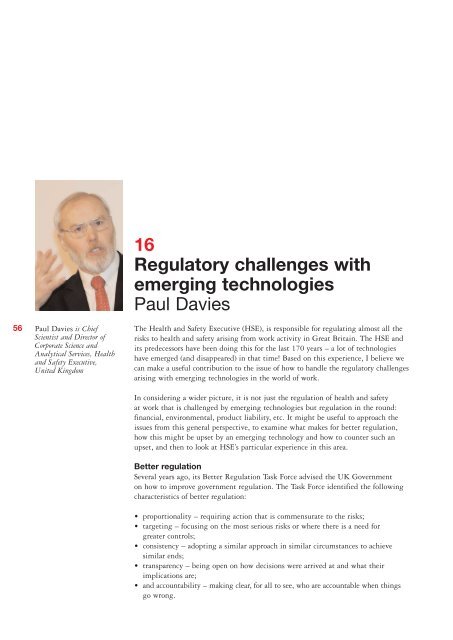Small size - large impact - Nanowerk
Small size - large impact - Nanowerk
Small size - large impact - Nanowerk
You also want an ePaper? Increase the reach of your titles
YUMPU automatically turns print PDFs into web optimized ePapers that Google loves.
56<br />
Paul Davies is Chief<br />
Scientist and Director of<br />
Corporate Science and<br />
Analytical Services, Health<br />
and Safety Executive,<br />
United Kingdom<br />
16<br />
Regulatory challenges with<br />
emerging technologies<br />
Paul Davies<br />
The Health and Safety Executive (HSE), is responsible for regulating almost all the<br />
risks to health and safety arising from work activity in Great Britain. The HSE and<br />
its predecessors have been doing this for the last 170 years – a lot of technologies<br />
have emerged (and disappeared) in that time! Based on this experience, I believe we<br />
can make a useful contribution to the issue of how to handle the regulatory challenges<br />
arising with emerging technologies in the world of work.<br />
In considering a wider picture, it is not just the regulation of health and safety<br />
at work that is challenged by emerging technologies but regulation in the round:<br />
financial, environmental, product liability, etc. It might be useful to approach the<br />
issues from this general perspective, to examine what makes for better regulation,<br />
how this might be upset by an emerging technology and how to counter such an<br />
upset, and then to look at HSE’s particular experience in this area.<br />
Better regulation<br />
Several years ago, its Better Regulation Task Force advised the UK Government<br />
on how to improve government regulation. The Task Force identified the following<br />
characteristics of better regulation:<br />
• proportionality – requiring action that is commensurate to the risks;<br />
• targeting – focusing on the most serious risks or where there is a need for<br />
greater controls;<br />
• consistency – adopting a similar approach in similar circumstances to achieve<br />
similar ends;<br />
• transparency – being open on how decisions were arrived at and what their<br />
implications are;<br />
• and accountability – making clear, for all to see, who are accountable when things<br />
go wrong.
















